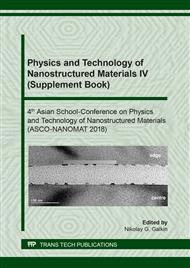[1]
Singh, K., Antiferroelectric lead zirconate, a material for energy storage., Ferroelectrics 94.1, 433-433 (1989).
DOI: 10.1080/00150198908014299
Google Scholar
[2]
Scott J.F., Applications of modern ferroelectrics, Science 315(5814), 954-959 (2007).
Google Scholar
[3]
Mischenko, A. S., et al., Giant electrocaloric effect in thin-film PbZr0.95Ti0.05O3, Science 311.5765, 1270-1271 (2006).
Google Scholar
[4]
Chaudhuri A. R., Arredondo M., Hähnel A., Morelli A., Becker M., Alexe M., and Vrejoiu I., Epitaxial strain stabilization of a ferroelectric phase in PbZrO3 thin films, Phys. Rev. B. 84(5), p.054112 (2011).
DOI: 10.1103/physrevb.84.054112
Google Scholar
[5]
Glazkova-Swedberg, E., et al., Electrocaloric effect in PbZrO3 thin films with antiferroelectric-ferroelectric phase competition, Computational Materials Science 129, 44-48 (2017).
DOI: 10.1016/j.commatsci.2016.12.002
Google Scholar
[6]
Boldyreva K., Pintilie L., Lotnyk A., Misirlioglu I. B., Alexe M., and Hesse D. Thickness-driven antiferroelectric-to-ferroelectric phase transition of thin PbZrO3 layers in epitaxial PbZrO3∕ Pb(Zr0.8Ti0.2)O3 multilayers. Appl. Phys. Lett. 91(12), p.122915 (2007).
DOI: 10.1063/1.2789401
Google Scholar
[7]
Yamakawa K., K. W. A. Gachigi, S. Trolier-McKinstry, and J. P. Dougherty, Phase transitions of antiferroelectric lead zirconate thin films in high electric field. Ferroelectrics Letters Section, 20(5-6), 149-155 (1996).
DOI: 10.1080/07315179608204733
Google Scholar
[8]
Pintilie L., Boldyreva K., Alexe M., and Hesse D., Coexistence of ferroelectricity and antiferroelectricity in epitaxial PbZrO3 films with different orientations. J. Appl. Phys. 103(2), p.024101 (2008).
DOI: 10.1063/1.2831023
Google Scholar
[9]
Dobal P. S., Katiyar R. S., Bharadwaja S. S. N., and Krupanidhi S. B., Micro-Raman and dielectric phase transition studies in antiferroelectric PbZrO3 thin films. Appl. Phys. Lett. 78(12), 1730-1732 (2001).
DOI: 10.1063/1.1356730
Google Scholar
[10]
Zhai J., and Chen H. Direct current field and temperature dependent behaviors of antiferroelectric to ferroelectric switching in highly (100)-oriented PbZrO3 thin films. Appl. Phys. Lett. 82(16), 2673-2675 (2003).
DOI: 10.1063/1.1569420
Google Scholar
[11]
Pertsev, N. A., A. G. Zembilgotov, and A. K. Tagantsev. Equilibrium states and phase transitions in epitaxial ferroelectric thin films. Ferroelectrics 223.1, 79-90 (1999).
DOI: 10.1080/00150199908260556
Google Scholar
[12]
Mani B. K., et al. Critical Thickness for Antiferroelectricity in PbZrO3. Physical Review Letters 115.9 (2015): 097601.
Google Scholar
[13]
Roobol, Sander, et al. BINoculars: data reduction and analysis software for two‐dimensional detectors in surface X‐ray diffraction. Journal of applied crystallography 48.4, 1324-1329 (2015).
DOI: 10.1107/s1600576715009607
Google Scholar
[14]
Whatmore R.W., Glazer A.M. Structural phase transitions in lead zirconate. Journal of Physics C: Solid State Physics.12 1505 (1979).
DOI: 10.1088/0022-3719/12/8/012
Google Scholar
[15]
Lityagin G. et at. Intermediate phase with orthorhombic symmetry displacement patterns in epitaxial PbZrO3 thin films at high temperatures, Ferroelectrics (2019), /in press/.
Google Scholar
[16]
Holy, Vaclav, Tilo Baumbach, and Ullrich Pietsch. High-resolution X-ray scattering from thin films and multilayers. Springer (1999).
Google Scholar
[17]
Boulle, A., et al. A new method for the determination of strain profiles in epitaxic thin films using X-ray diffraction. Journal of applied crystallography 36.6, 1424-1431 (2003).
DOI: 10.1107/s0021889803020351
Google Scholar
[18]
J.W. Matthews and A.E. Blakeslee, Defects in epitaxial multilayers: I. Misfit dislocations, Journal of Crystal Growth 27, 118-125 (1974).
DOI: 10.1016/0022-0248(74)90424-2
Google Scholar
[19]
Abbaschian, Reza, and Robert E. Reed-Hill. Physical metallurgy principles. Cengage Learning, (2008).
Google Scholar


